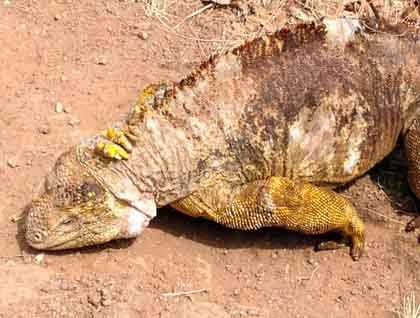Located at the center of Galapagos, Santa Cruz is the second largest island on the archipelago. After a short navigation early in the morning, we arrived to Dragon Hill, named in honor of one of the iconic endemic species of the islands, the land iguana. It was a sunny and windy day, as we headed to the landing dock, observing some migratory birds and blue-footed boobies resting on the rocks along the shallows. Juvenile sea lions captivated our guests. Walking through the small forest of cacti, we observed their long thorns, used to protect them against predators such as iguanas and giant tortoises, found along this part of the island. We crossed the white beach, observing great blue herons and some marine iguanas warming up with the first beams of the day. As we travelled inland, the landscape changed dramatically as we arrived to a forest of stripped palo santo trees, having all shed their leaves, in order to avoid dehydration during the dry season. Behind the beach, two flamingos walked indifferently along the brackish lagoon, lowering their heads into the water and feeding on small crustaceans. Closer to the shore, black-necked stilts and some phalaropes walked along the mud catching small crabs.
We finally arrived to the land iguana’s territory. The soft terrain here is perfect for nesting or resting inside, and the presence of several burrows indicated us that there were iguanas in the vicinity. We were fortunate enough to encounter several land iguanas along the small hill, some of them very close to us, but in all cases with no fear, something unique but common with endemic species in the Galapagos. After almost three hours walking along Dragon Hill, we finally returned to our ship, to prepare for snorkeling excursions in Guy Fawkes islets.
During lunch, our guests enjoyed a delicious Ecuadorian buffet, featuring the most representative dishes of the Ecuadorian cuisine. The delicious meal recharged our batteries, and we were ready to continue our exploration along the calm seas of the Pacific Ocean. After few hours of sailing, and we arrived to Daphne Major. This very old tuff cone volcanic island, is where many famous scientists have studied finches over the years, following the footsteps of the most well-known visitor, the famous Charles Darwin, who based his theory of evolution on his observations on the Galapagos Islands. Around the islet, we observed many sea birds that nest along the shoreline such as Nazca boobies, blue-footed boobies and sea gulls.
The day ended with an incredible sunset, a beautiful ending to this incredible day that will remain with us forever.







